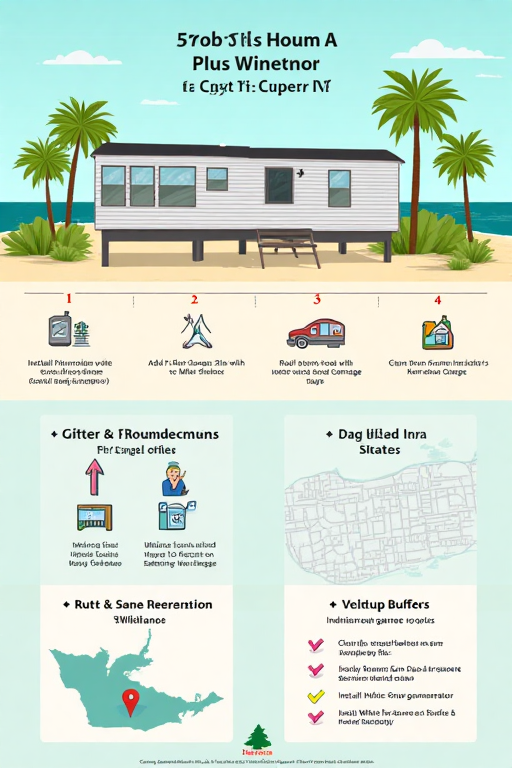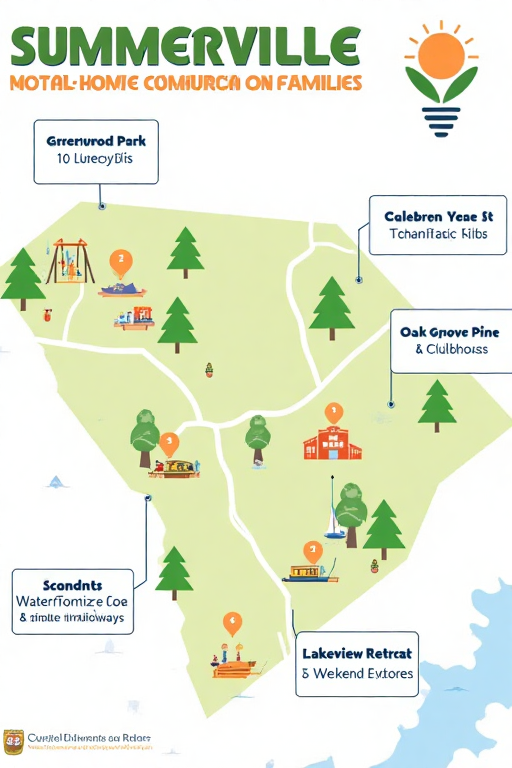Seasonal Maintenance Checklist for Mobile Homes in South Carolina
Your Guide from Faith Mobile Home Solutions
Introduction
Maintaining your mobile home in South Carolina requires a thoughtful seasonal approach to address the region’s unique climate challenges—from humid summers to stormy springs and mild winters. A proactive maintenance routine preserves your home’s value, prevents costly repairs, and ensures comfort year‑round. This guide lays out a detailed checklist for spring, summer, fall, and winter maintenance tasks, plus year‑round inspections, tools you’ll need, budgeting tips, legal considerations, and expert advice from Faith Mobile Home Solutions.
Spring Maintenance
1. Roof and Gutters: Clear debris, inspect for leaks or damage, re‑seal seams and flashing. Ensure gutters and downspouts are free‑flowing to handle heavy spring rains.
2. Exterior Cleaning: Power‑wash siding, decks, and patios to remove mold, mildew, and pollen buildup.
3. HVAC Servicing: Change filters, clean ductwork, check for coolant leaks, and schedule professional tune‑up to prepare for summer cooling demands.
4. Plumbing Inspection: Check all faucets, pipes under sinks, and exterior hose bibs for winter freeze damage, leaks, or corrosion.
5. Foundation and Skirting: Inspect crawl space skirting for cracks or pest entry, ensure vent screens are intact, and reinforce insulation under the home.
6. Deck and Stairs: Inspect for loose boards or railings, sand and seal wood surfaces, and repair or replace damaged sections.
7. Pest Control: Treat perimeter for ants, termites, and rodents before insect season peaks.
8. Landscape Refresh: Prune shrubs away from siding, fertilize lawn, reseed bare patches, and mulch garden beds to suppress weeds.
9. Smoke & CO Detectors: Replace batteries and test all detectors.
10. Emergency Kit Check: Replenish supplies—flashlights, batteries, first aid, and storm‑ready tools.
Summer Maintenance
1. Air Conditioner Performance: Clean evaporator and condenser coils, check refrigerant, and ensure optimal airflow around outdoor unit.
2. Window & Door Seals: Inspect weatherstripping for gaps or wear, re‑caulk frames to reduce cooling loss.
3. Deck and Patio Shade: Install or repair awnings, shade sails, or umbrellas to protect outdoor living spaces and reduce heat gain.
4. Insulation Check: Verify attic and wall insulation integrity; add insulation if needed to combat heat transfer.
5. Attic Ventilation: Ensure attic vents are clear; consider adding ridge vents or powered attic fans to expel hot air.
6. Electrical Panel: Check breaker function, tighten connections, and ensure outdoor outlets are GFCI protected for safety.
7. Roof Vent Screens: Inspect and clear any debris blocking soffit or gable vents to improve attic airflow.
8. Pool or Spa Maintenance: If applicable, service pumps, clean filters, and balance water chemistry.
9. Water Heater: Drain and flush tank to remove sediment buildup and improve efficiency.
10. Storm Prep: Test backup generator, stock up on emergency water and fuel before hurricane season.
Fall Maintenance
1. Gutter Cleaning: Remove leaves and debris to prevent clogs before winter rains.
2. Seal Exterior Cracks: Inspect foundations, skirting, and siding for gaps; apply sealant or repair materials.
3. Heating System Tune‑Up: Replace furnace filters, check pilot lights or ignition systems, clean burners, and schedule professional service.
4. Chimney & Fireplace: If you have them, clean and inspect for creosote buildup or blockages.
5. Insulate Pipes: Add foam sleeves to exposed pipes in crawl space and utility rooms to prevent freeze damage.
6. Exterior Lighting: Replace bulbs, check timers or sensors, and clean fixtures to ensure safety during shorter days.
7. Lawn Dormancy Prep: Aerate, fertilize for root health, and lay down winter rye grass seed in shaded areas.
8. Winterize Tools: Service lawnmowers, blowers, and other outdoor equipment; drain fuel and store properly.
9. Deck Winter Seal: Apply water‑repellent sealant to wood surfaces to protect against freeze‑thaw cycles.
10. Emergency Contacts: Update contractor and utility provider phone lists; post on fridge for quick access.
Winter Maintenance
1. Snow & Ice Removal: Install snow guards on roof edges, keep ice melt on hand, and clear pathways promptly.
2. Roof Inspection: Check for ice dams, clear heavy snow accumulation safely to prevent structural stress.
3. Condensation Control: Use dehumidifiers, ensure proper ventilation to reduce indoor moisture and mold risk.
4. Heater Operation: Monitor carbon monoxide detectors, keep flues clear, and test emergency heating devices.
5. Pipe Monitoring: Check for slow leaks or freeze stress, and allow faucets to drip during extreme cold.
6. Exterior Faucets & Hoses: Disconnect hoses, drain exterior faucets, and cover with insulated caps.
7. Smoke & CO Test: Again, confirm all detectors function properly during high‑use heating season.
8. Stock Emergency Supplies: Keep rock salt, extra blankets, and non‑perishable food accessible in case of storms.
9. Attic & Crawl Space: Verify insulation hasn’t shifted; ensure vents are closed or screened against rodents.
10. Interior Caulking: Seal gaps around window trim and door frames to minimize drafts.
Year‑Round Maintenance & Inspections
1. Monthly Checks: Change HVAC filters; test GFCI outlets; inspect smoke and CO detectors.
2. Quarterly Tasks: Test sump pumps; run water through unused fixtures; check for hidden leaks under sinks.
3. Annual Professional Inspections: Engage qualified contractors for thorough roof, foundation, and system assessments.
4. Pest Prevention: Maintain perimeter treatments; seal entry points and store firewood off the ground.
5. Documentation: Keep detailed logs of all maintenance, repairs, and inspections to support warranties and insurance claims.
Tools & Supplies Checklist
- Power washer
- Extension ladder with stabilizers
- Caulking gun & exterior sealant
- Weatherstripping materials
- HVAC filter replacements
- Pipe insulation sleeves
- Dehumidifier
- Snow shovel & ice melt
- Basic hand tools (screwdrivers, wrenches, hammer)
- Safety gear: gloves, goggles, hard hat
Budgeting & Financing Your Maintenance
Establish an annual maintenance budget—typically 1–3% of your home’s value—to cover routine and emergency tasks. Consider low‑interest home improvement loans or refinancing options through Faith Mobile Home Solutions to fund significant upgrades or emergency repairs without straining your cash flow.
Legal & Safety Considerations
Ensure all structural changes and major repairs comply with South Carolina building codes and mobile home installation standards. Obtain necessary permits for deck rebuilds, roofing replacements, or electrical upgrades. Always use licensed professionals for gas, electrical, and structural work to maintain safety and warranty coverage.
Expert Tips from Faith Mobile Home Solutions
- Stay Ahead of Weather: Check forecasts before major tasks; avoid outdoor work during storms.
- Routine Beats Reactive: Quarterly inspections catch small issues before they become costly repairs.
- Document Everything: Maintain a digital log with date‑stamped photos to track home condition and support warranty/insurance claims.
- Invest in Quality: Higher‑grade materials often pay off with longer lifespans and reduced maintenance.
- Build Relationships: Work with local contractors familiar with mobile home specifics and South Carolina climate factors.
Conclusion
A disciplined, seasonal maintenance routine is the key to preserving your mobile home’s condition, ensuring safety, and maximizing its lifespan and value. By following this comprehensive checklist and leveraging expert advice from Faith Mobile Home Solutions, South Carolina homeowners can proactively protect their investment against the region’s varied weather and environmental challenges. Start today to build a maintenance habit that keeps your home comfortable and secure year‑round.
Frequently Asked Questions (FAQs)
1. How often should I inspect my mobile home’s roof?
Inspect your roof every spring and fall, and after major storms, to catch damage early.
2. What’s the ideal HVAC filter change frequency?
Replace filters every 1–3 months, depending on usage and indoor air quality.
3. How do I prevent mold in my mobile home?
Use dehumidifiers, maintain proper ventilation, and address leaks promptly.
4. When should I re-seal my deck?
Re-seal wood decks every 1–2 years, typically in spring before heavy use.
5. How do I winterize outdoor faucets?
Disconnect hoses, drain faucets, and install insulated covers to prevent freeze damage.
6. What plants work best for South Carolina landscapes?
Native varieties like azaleas, camellias, and ornamental grasses thrive with minimal care.
7. Can I DIY gutter cleaning?
Yes—use sturdy ladders and gloves. For multi-story or complicated roofs, hire a professional.
8. How do I check for crawl space pests?
Look for droppings, damaged skirting, or nesting materials; set traps or call pest control.
9. Is it necessary to service my water heater annually?
Yes, annual flushing and inspection help prevent sediment buildup and extend its life.
10. How can I test emergency lighting?
Press the test button on each unit quarterly and replace batteries as needed.
11. What safety gear do I need for home maintenance?
At minimum: gloves, safety goggles, non-slip shoes, and a hard hat for overhead work.
12. How do I know when to call a professional?
If a task involves structural, electrical, or plumbing systems beyond basic DIY skills, hire a licensed contractor.
13. Can maintenance issues affect my home insurance?
Poor maintenance can lead to claim denials. Keep up with routine tasks and document them.
14. How much should I budget annually for maintenance?
Aim for 1–3% of your home’s value per year to cover routine and unexpected repairs.
15. Are there local rebates for energy-efficient upgrades?
South Carolina offers occasional utility rebates for insulation, HVAC, and solar installations—check local energy providers.
16. How can I improve attic ventilation?
Install ridge vents, soffit vents, or a powered attic fan to promote airflow and reduce heat buildup.
17. Should I schedule maintenance around hurricane season?
Yes—complete exterior checks and reinforce structural elements before June’s start for better storm resilience.
18. What’s the best way to maintain skirting?
Inspect quarterly for cracks or pest entry points; repair with matching panels and sealants.
19. How often should I flush my water heater?
Annually, to remove sediment and maintain heating efficiency.
20. Can refinanced funds be used for maintenance?
Yes—refinancing can free equity to fund major maintenance or upgrades without dipping into savings.
21. Is mold testing necessary after water damage?
Yes—professional testing identifies hidden mold and informs proper remediation steps.
22. How do I prevent pest infestations?
Seal gaps, keep vegetation trimmed, and schedule quarterly pest treatments to deter insects and rodents.
23. What’s the best paint for humid climates?
Use 100% acrylic exterior paint with mildew-resistant additives for durability and moisture protection.
24. How do I inspect for foundation settling?
Look for uneven floors, cracks in skirting, or gaps between steps and the home; consult a professional if found.
25. Where can I learn more about mobile home upkeep?
Visit Faith Mobile Home Solutions online, attend local maintenance workshops, and consult trusted contractor blogs for deeper insights.
Additional Keywords
- seasonal maintenance
- mobile home upkeep
- South Carolina home care
- Faith Mobile Home Solutions
- spring checklist
- summer tasks
- fall preparations
- winter readiness
- year‑round care
- roof inspection
- HVAC filter change
- gutter cleaning
- pest prevention
- deck sealing
- pipe insulation
- attic ventilation
- storm prep
- energy efficiency
- water heater flush
- foundation check
- landscape pruning
- permit requirements
- professional contractors
- maintenance budget
- DIY mobile home repair




